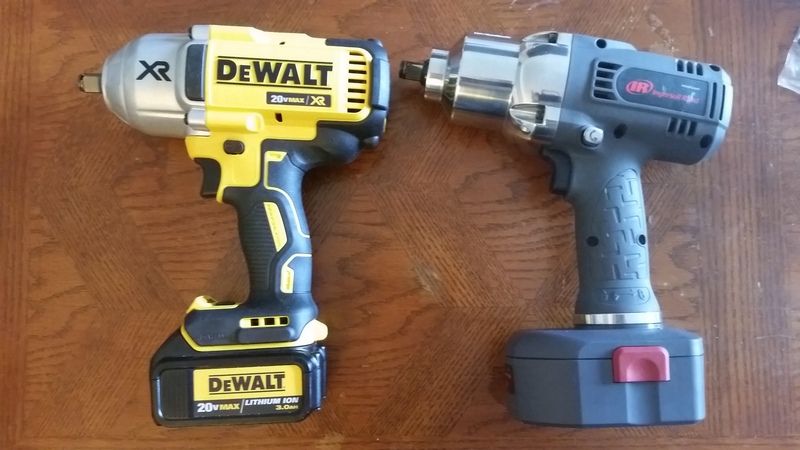Forum Replies Created
- AuthorReplies
For a striking tool it’s very important to use the right alloys and heat treatment. Welding can ruin the proper heat treatment of the hammer head. Welds can fail unless you re-heat treated the hammer. Hickory is an excellent material, shock absorbing and durable when properly done.
I like Precision Instruments spit-beam torque wrenches, they make a 3/4″ model up to 600 ft-lbs. Think the key for you is a custom reaction plate to work with the multiplier. Our AMSA shop guys fabricate their own for military vehicles from designs they find.
Is there a reason you can’t re-hang the hickory handle or get a new one? What you did with the pins might be part of the problem, only metal you should have is a small cross-wedge slotted into the main wedge. Boiled linseed oil will expand the wood a bit and ensure a very tight fit too.
DeWalt DCF889H 20V 1/2″ cordless impact. Next to my IR W360 impact, the DeWalt is nearly a pound heavier as shown.

I have an IR cordless 1/2″ impact and I just ordered the DeWalt DCF889H 20V 1/2″ impact to replace it. IR makes great tools but Milwaukee and DeWalt make stronger cordless 1/2″ impacts right now. Only reason to go with IR is if you plan on buying into the rest of their iQ line up and you do production/industrial work. For the average and even serious mechanic I don’t see the benefit in spending more for that particular tool anymore, the Milwaukee and DeWalt versions are significantly more powerful, easier to get batteries for, cheaper, and you can have commonality with a much greater range of cordless tools.
The question is if the impact wrench is the only reason you are getting an air compressor? Air compressor will give you more versatility as far as tools and utility. That utility is limited to the capacity and duty-cycle rating of the air compressor too. A 28 gallon air compressor will give you some options up to running an impact intermittently along with a few other tools like ratchets and nail guns but you would probably need something a bit bigger with a higher CFM and duty-cycle rating for extended jobs or using tools like drills, sanders, grinders, etc. Electric cordless impacts are now easily equal to even very good 1/2″ air impacts with a strong compressor behind them. I have an Ingersoll-Rand IQ 1/2″ impact with around 700 ft-lbs max reverse torque, nothing I’ve ever wrenched on would give that tool trouble and it’s rated for fleet service use. It’s an expensive tool but I can just toss it in the truck without worrying about dragging along a compressor, hose, extension cord, and hoping whatever outlet I plug into will support it. With cordless tools it’s ready as long as the battery is charged. Pros and Cons either way. I plan on installing a 60 gallon air compressor in the near future so I can have the best of both worlds.
3.55’s are an excellent choice for Fox chassis Fords with a 5-speed manual. Especially when stepping up from 2.73’s or 3.08’s. Heavier SN95 and NE Mustangs and similar are better off with 3.73’s. If there was an automatic in place then a higher numerical gear would be more useful across the board.
Back before long-life coolant was the standard it was often recommended that brake fluid be changes out when the coolant was which was about every 2 – 3 years. Most people let the brake fluid go way longer than they should, it’s meant to be changed out at regular intervals.
No, you are making yourself look like anything but the “professional” you think you are. Typical of the paste eater in the back of the class. You had to lie about somebody else’s posts to make a point nobody but you thought was important. Laughable.
I don’t tolerate those that make up shit about what somebody else posts. I don’t give a shit about what you think on anything else either, I deal with professionals, not children.
The piston and cylinder head absorb a lot of the heat left over that didn’t go out the exhaust. Heat into the cylinder head is transferred to the coolant system mostly and heat into the piston is transferred to the cylinder wall via the piston rings. Engine oil carries away some of that heat and the rest is absorbed by the coolant system. The combustion process is fast but it’s happening a lot so you can almost consider the heat transfer to be a steady state process for a given RPM/load.
Nice, dishonest post you have there. I didn’t say anything about those teams using HF tools and you can try quoting where I did if you think so. I said those teams are often sponsored by tool suppliers and they sure as hell aren’t the only “professionals” in existence. I know pros that have a few random HF tools in their boxes and I know shade-tree mechanics with $20,000 in debt to Snap-On and MAC. Get over yourself.
Maybe not but they aren’t the only professionals either. One shop doesn’t mean anything.
Price is also determined by the additive package and Premium grade fuels usually have more detergent additives than lesser grade fuels. This also applies in the difference between Top Tier fuels and lesser brands.
Professionals will use what the can afford if they are smart. Lot of those pro teams are sponsored by tool suppliers, they aren’t paying street prices if they are paying at all. I can afford all the professional mechanics tools I want but there are some tools at HF that are a decent value and more so if they are tools that take abuse prying and striking tools. Real professionals know where they need to spend their money and where they can save it.
- AuthorReplies
 Our Address
Our Address
